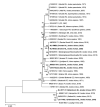Continued Circulation of Tick-Borne Encephalitis Virus Variants and Detection of Novel Transmission Foci, the Netherlands
- PMID: 36288572
- PMCID: PMC9707572
- DOI: 10.3201/eid2812.220552
Continued Circulation of Tick-Borne Encephalitis Virus Variants and Detection of Novel Transmission Foci, the Netherlands
Abstract
Tick-borne encephalitis virus (TBEV) is an emerging pathogen that was first detected in ticks and humans in the Netherlands in 2015 (ticks) and 2016 (humans). To learn more about its distribution and prevalence in the Netherlands, we conducted large-scale surveillance in ticks and rodents during August 2018-September 2020. We tested 320 wild rodents and >46,000 ticks from 48 locations considered to be at high risk for TBEV circulation. We found TBEV RNA in 3 rodents (0.9%) and 7 tick pools (minimum infection rate 0.02%) from 5 geographically distinct foci. Phylogenetic analyses indicated that 3 different variants of the TBEV-Eu subtype circulate in the Netherlands, suggesting multiple independent introductions. Combined with recent human cases outside known TBEV hotspots, our data demonstrate that the distribution of TBEV in the Netherlands is more widespread than previously thought.
Keywords: Apodemus; Ixodes ricinus; Microtus; Myodes; antibodies; arbovirus; distribution; emergence; human cases; monitoring; rodent; sentinel; surveillance; the Netherlands; tick-borne encephalitis; tick-borne encephalitis virus; tickborne disease; vector-borne infections; viruses.
Figures


References
Publication types
MeSH terms
LinkOut - more resources
Full Text Sources

